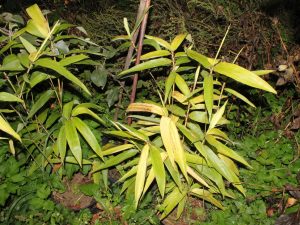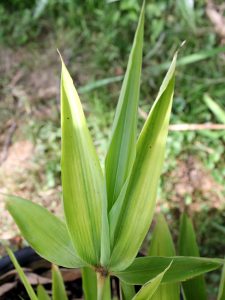Moso and yellow leaves
Recently, someone asked me for advice about his yellowing Moso seedlings. I remember banging my head into the wall, trying to realize what was wrong with my Moso seedlings, when I was desperately trying to grow them from seed. At that point I have had no idea about the cause of yellowing and I was doing way too much (all the wrong things :)) to save them. In the end, all the pampering, fertilization, foliar sprays, excessive watering, moving them around from shade to half shade, full sun and back again, didn’t help them. Most of the seedlings from that time died a terrible death, except for one, which is growing vigorously.

- waterlogged soil
- too much sun
- soil heats up too much during the day
nutrient deficiency
Moso is terrible when grown in containers. Even if it’s already well established in it’s pot, it can get dry quickly, but it will immediately suffer if watered too much so it starts becoming water logged, roots will start rotting, water consumption will become minimal, soil will remain wet and it will start to die. Rather keep it on a dry side, at least partly shaded and protected from strong winds.

In late fall or early summer when temperatures are low enough to allow sunbathing, dark pots can get extremely hot. In overheated soil, roots and rhizomes get damaged, start rotting and seedling starts to decline. Pots have to be protected from sun exposure, so the soil temperature remains constant and low enough. The best option is to bury the pots.
Why I struck through nutrient deficiency? At least for me, it was never deficiency. It can be though!
Yellowing usually occur when there’s nitrogen deficiency. In case of N deficiency, new leaves remain dark green, but older foliage starts to turn yellow. Seedling transfers all the nutrients from old leaves into new ones. Iron deficiency makes the leaves turn yellow, but the veins remain green. It starts showing in new leaves first, in severe cases older leaves also get affected.
Sulfur deficiency hits the whole plant at the same time, which means new and old leaves turn yellow at the same time. Leaf veins get yellow as well.
Magnesium deficient plants start yellowing in the older leaves, then yellowing spreads to newer leaves if deficiency is severe.
… but usually it’s not deficiency at all.
To improve my seedling’s chances I now prepare my soil mix myself. I use garden soil, 2 years old compost (kitchen scraps, grass clippings, wood chips,…), peat moss, partly decomposed wood chips and some sand or gypsum. Soil holds water well enough, there are many air pockets inside and a it offers a lot of nutrients.
Most common mistakes:
- using cheap pure peat moss ‘soil’
- up-potting into large container
- mindless watering and fertilization
The main cause of waterlogging is usually inappropriate soil mix. If there’s too much organic material in the soil, it can hold and lock-in a lot of water. Peat moss, and coconut fiber based soil mix can hold water like a sponge, which leads to yellowing and death of young Moso seedlings.
In a small pot, there will be a lot of roots that will make the soil more porous allowing excess water to drain out of the pot. If there are many roots and established plant above the soil level, water consumption will be high enough to use the water before it becomes an issue. When transplanting the seedling into large (too large) pot, soil can get too wet, preventing seedling’s roots to conquer newly acquired space.

Sometimes when soil is already saturated with water, leaves will start showing the same signs of stress as if the soil would be dry. Wilted leaves don’t necessarily mean that seedling needs more water, if soil looks moist, do not water. If leaves start to turn yellow and you suspect nutrient deficiency, only use mild concentration of fertilizer with the next watering. If issue doesn’t go away after a week or two, it most likely isn’t nutrient deficiency related.